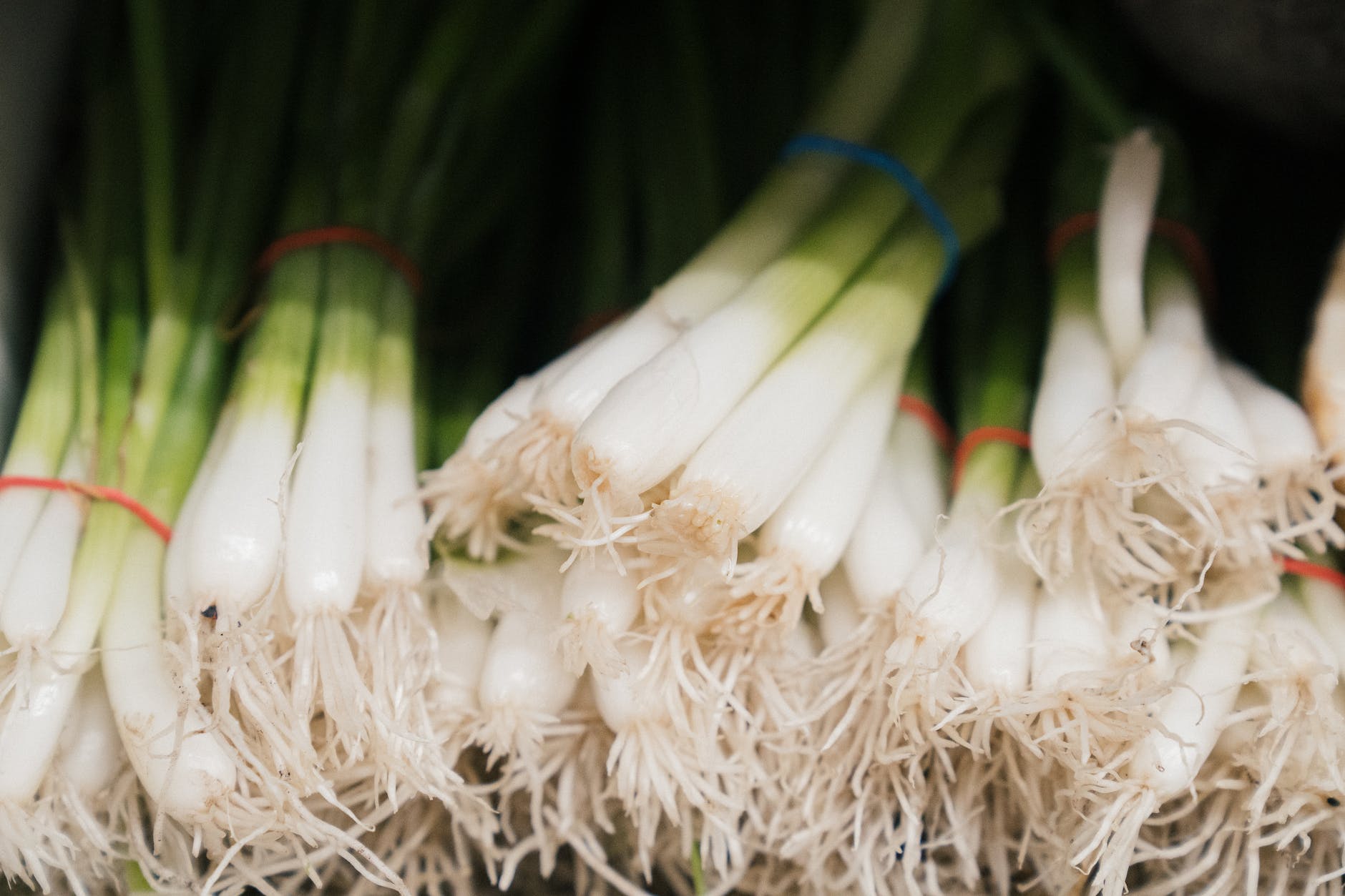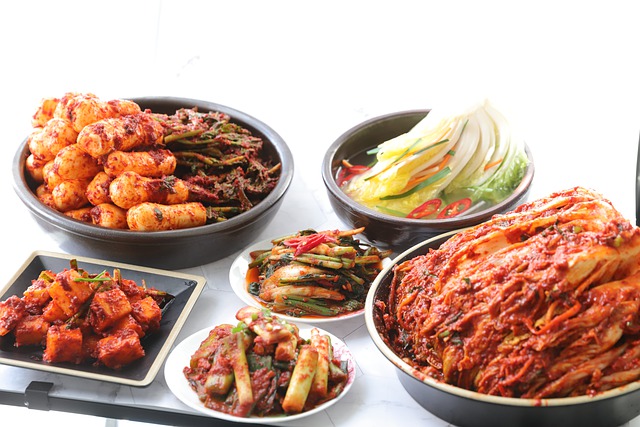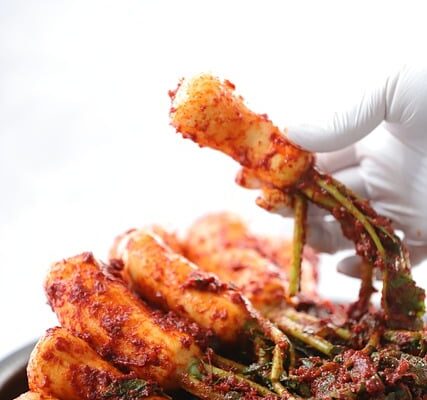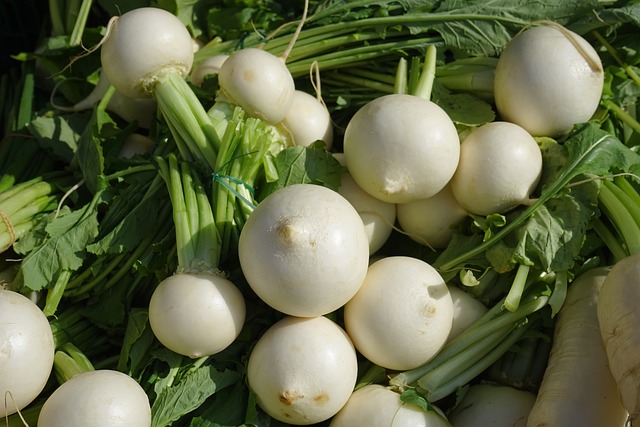We have more Kimchi recipes for you to try.
PONYTAIL RADISH KIMCHI (BACHELOR KIMCHI)
Bachelor kimchi, made using Ponytail radish, is a popular radish kimchi. Even after a long fermentation, it keeps its crunchiness. This mild radish kimchi is easy to make and tasty to eat! Everyone should try this at least once, in my opinion.
INGREDIENTS
- 3 1/4 pound bunches of young radishes
- 1/2 cup coarse Korean sea salt
- 5-6 dried big anchovies or 1 handful dried shredded pollock
- 2 tbsp (chapsal-garu) sweet rice flour
- 2 c. water
- 1 medium diced onion
- 1/2 diced apple
- 4 garlic cloves
- 1 teaspoon ginger
- 3 tablespoons anchovy sauce from Korea
- 1 tablespoon optional Korean salted shrimp
- 1 teaspoon sugar
- 1/2 cup gochugaru (Korean chili flakes)
INSTRUCTIONS
- Scrape off the filthy surface of the radish and chop off the tail. Keep the green leafy stem section of the radish attached. If the white section of the radish is too large, cut it in half or quarters. Rinse them thoroughly.
- Place the radishes in a big shallow basin in a kitchen sink and sprinkle with sea salt equally all over. Allow for a 2-hour soak, turning once or twice. Rinse the radishes several times in water and drain them in a strainer when they appear wilted and lifeless. Allow them to sit while you prepare the filling.
- Meanwhile, in a separate pot, bring 2 cups of water to a boil and simmer for an additional 5 minutes with dried pollock or anchovies. Attempt to reserve 3/4 cup + 2 tbsp of stock. Remove the fish.
- Combine 3/4 cup saved stock and 2 tablespoons of sweet rice flour in a small pot. Bring them to a boil and thicken over medium-high heat, whisking frequently. This is the sweet rice paste (you need 1/2 cup). Allow it to cool.
- Combine onion, apple, garlic, ginger, salted shrimp (optional) in a blender, and 2 tablespoons of reserved fish stock. Puree them till completely smooth. Add 1/2 cup of the prepared sweet rice paste, Korean chili flakes, anchovy sauce, and sugar to the mixture. Mix thoroughly and let aside for 10 minutes to allow the chili flakes to soften.
- Place the radishes in a big shallow mixing basin or a baking pan and smother with the chili mixture. To avoid overflowing, you may need to execute this in batches. To uniformly coat the radishes and their green stems, toss, rub, and integrate the chili mixture.
Store the radish kimchi in an airtight container for two days at room temperature before storing it in the refrigerator for five days. Your bachelor kimchi is now ready to consume. (Toss the Kimchi in the bottom with the kimchi juice)
GREEN TURNIP KIMCHI
Turnip green kimchi is a great fall kimchi to make because turnip greens are plentiful and inexpensive. Fresh red chile adds a refreshing and mild flavor.
INGREDIENTS
- 1.5-pound washed turnip greens
- 1/4 cup coarse Korean sea salt
- 1 1/2 cups of water
- 5 to 6 big dried anchovies
- 1 dried sea kelp (dashima) piece 2 dried shiitake mushrooms
- 1 tablespoon Chapsal-garu (sweet rice flour)
- 1/4 pound chopped fresh red chiles
- 1/2 diced onion
- 3 to 4 cloves garlic
- 1 ” ginger root
- 1/4 cup gochugaru (Korean chili flakes)
- 3 tbsp. Korean anchovy sauce
- 1 teaspoon of shrimp sauce
INSTRUCTIONS
- Place a few turnip greens on the bottom of a large shallow bowl. Sprinkle with a pinch of sea salt, roughly 1/2 teaspoonful. Repeat this until the turnip greens are completely covered. Depending on the volume, you may require extra salt.
- Allow them to sit on the counter for 1 hour, then flip them halfway upside down. They will be cut in half in volume. Rinse the turnip green several times with water. Set aside after draining.
- Make a stock in the meantime. In a small pot, combine 1-1/2 cups water, dried anchovies, sea kelp, and dried mushrooms. After bringing it to a boil, reduce the heat and simmer for an additional 5 minutes. Remove it from the heat and let it cool. Save 1 cup + 2 teaspoons of the stock and discard the remainder.
- To make rice glue, mix together 1 cup of saved stock and sweet rice flour in a small pot. Bring to medium-high heat and continue to stir until the mixture thickens. Remove from the heat and leave to cool.
- Puree onion, red chile, garlic, ginger, anchovy sauce, and shrimp sauce in a blender until semi-smooth. Fill a bowl halfway with the mixture. Mix in the Korean red chili flakes and the saved rice glue.
- Toss the turnip greens gently with your hand to incorporate the seasoning.
- Place the turnip green kimchi in an airtight container and leave it at room temperature for 2 days before storing it in the refrigerator. After 2-3 days, your Kimchi should be ready to eat.
NOTES: Turnip green kimchi can be stored in the refrigerator for about 2 months. They are still edible after 2 months but quite pungent and sour.
KIMCHI WITH GARLIC AND CHIVES (BUCHU KIMCHI)
Tender Korean garlic chives (also known as Chinese chives or Asian chives) provide a quick and excellent kimchi in 30 minutes. In your local Asian store, look for slender garlic chives.
INGREDIENTS
- 10 oz. garlic chives, washed and sliced into 2-3 lengthwise slices
- 1 cup of water
- 4 big dried anchovies
- 1/2 small diced onion
- 2 cloves garlic
- 1/2 inch diced ginger
- 1/3 cup gochugaru (Korean chili flakes)
- 1 tablespoon salty Korean shrimp
- 2–3 tablespoons Korean anchovy sauce
- 2 teaspoon sugar
INSTRUCTIONS
- Add water and dried anchovies to a small pot, bring to a boil, and let it simmer for 5-7 minutes. You just need 1/2 cup of the stock, so discard the rest.
- Combine the onion, garlic, ginger, and anchovy stock in a blender and blend until smooth.
- Combine the puree, chili flakes, salted shrimp, 2 tablespoons anchovy or fish sauce, and sugar in a large mixing bowl. Combine thoroughly.
- To coat, add the chives and mix thoroughly. Taste the Kimchi and adjust the seasoning to your liking.
- Place the chive kimchi in an airtight jar and leave to ferment at room temperature for 1-2 days before storing in the fridge for another 2 days before serving. Serve with rice and other traditional Korean meals.
GREEN ONION KIMCHI (PA KIMCHI)
Pa kimchi is a quick and tasty twist on traditional Korean Kimchi. It’s ready in 25 minutes and made with fresh green onions, Korean chili flakes, and fish sauce. It’s the perfect side dish or condiment for any Korean meal. A vegan diet can be modified.
INGREDIENTS
- 1 1/2 lb (750 g) clipped green onion
- 1/2 small diced onion
- 1 inch (2.5 cm) seeded and diced 1/2 small sweet apple or 1/4 Asian pear peeled and sliced fresh ginger
- 6 tablespoons (90 mL) Anchovy sauce from Korea
- 2 tablespoons (30 mL) Optional Korean plum extract (maeshil cheong)
- 2/3 cup (160 ml) Gochugaru (Korean chili flakes)
INSTRUCTIONS
- Combine the onion, apple (or Asian pear), ginger, anchovy sauce, and Korean plum extract (if using) in a small blender. To make a paste, blend everything together until smooth.
- In a bowl, combine the fragrant paste and the Korean chili flakes (gochugaru). Allow about 5 minutes for the gochugaru to rehydrate and increase in color, generating a paste-like consistency.
- Apply the spice paste to a small amount of the green onion, distributing it evenly around the onion. Repeat with the remaining green onions before storing the pa kimchi in an airtight container.

Allow it to sit at room temperature for one day before storing it in the refrigerator. While it can be drunk right away, the flavor will develop more as it ferments in the fridge for two to three weeks. When serving, cut the pa kimchi into the required size with a knife or a pair of kitchen scissors.
Expert Tip: A shallow baking sheet is ideal for creating pa kimchi.
NOTES: When shopping for green onions for pa kimchi, aim for slim green onions with a vivid color. Both the white and green sections can be used in the Kimchi, but any roots or rough outer layers should be removed. And don’t forget to wash and dry them before using them in your recipe!
THE BEST VEGAN KIMCHI RECIPE
Crisp, tangy vegan kimchi dish with true Korean flavors without the use of fish sauce. Discover how to improve fermentation, ingredients, and savory substitutions. A must-try for both vegetarians and kimchi fans!
INGREDIENTS
- 4 1/2 lb (2 kg) cabbage napa
- 1 1/2 cup (360 ml) FOR VEGETABLE-FRUIT STOCK, use 1/3 cup coarse sea salt from Korea or 1/3 cup kosher salt.
- 1/4 pound (113 g) chopped onion or leek Diced Korean radish or daikon radish
- 2 huge dried sea kelp (dashima) pieces
- 1/2 sweet red apple, 1/2 Asian pear or Bosc pear
- 6 cups water (1.4 liters)
TO MAKE KIMCHI PASTE
- 1 big sliced onion
- 10 garlic cloves
- 1-2 inch peeled and sliced ginger
- 1/2 peeled, cored, and diced Asian or Bosc pear
- 1/2 cored and diced sweet red apple
- 4 tbsp cooked white rice or plain potato
- Optional: 4-5 fresh red finger long chilies, chopped
- 2/3 cup (160 ml) Gochugaru (Korean chili flakes)
- 4 tbsp (gukganjang) Korean soup soy sauce
- 1 bunch chopped green onion
TO SEASON THE CABBAGE
- Half the cabbage lengthwise, leaving about 3-4 inches of the stem attached. Hand-separate the halves, then repeat the process to make quarters. Rinse and cut the cabbage into 2-inch sections.
- Spread a small amount of cabbage in a large mixing bowl, then evenly sprinkle 3-4 tablespoons coarse salt (1 tablespoon kosher salt), and repeat until all of the cabbage is utilized. If the cabbage appears dry, sprinkle it with water and press it down with your hands. Allow it to soak for 1 1/2 to 2 hours, rotating it halfway through.
- Bending the white stem piece is one approach to monitor the stage of cabbage brining. It is ready if it bends without breaking. Rinse the cabbage three times and drain thoroughly in a strainer.
IN ORDER TO CREATE THE VEGETABLE STOCK
Make the vegetable-fruit stock while the cabbage is brining by blending pear, apple, radish, onion, dried sea kelp, and water in a pot. Boil and then simmer for 20 minutes over medium heat, discarding the sea kelp after 5 minutes. Remove the ingredients and set aside 1-1/2 cups of the stock. Allow it to cool.
HOW TO CREATE KIMCHI PASTE
- Blend the onion, garlic, ginger, pear, apple, cooked potato (or white rice), and 1/2 cup of stock until smooth. If you’re using fresh red chile, add it at the end and pulse a few times.
- Pour the purée into a mixing bowl and stir in the Korean chili flakes and Korean soup soy sauce. Allow about 5 minutes for the chili flakes to absorb the flavor and rehydrate.
INSTRUCTION
- Combine the cabbage and sliced green onion in a large mixing bowl, then add the kimchi paste and toss to coat all of the cabbage pieces.
- Wearing kitchen gloves or disposable plastic gloves is recommended to avoid getting chili stains on your hands.
- Put the Kimchi in a storage container. If you want more kimchi brine, combine the remaining 1 cup of stock with the Kimchi in the mixing bowl. Rinse the bowl to collect all of the kimchi paste residue and pour it over the Kimchi.
- Remember that the cabbage will continue to produce brine spontaneously while it ferments, so don’t add too much stock.
- Leave the Kimchi to sit at room temperature for a couple of days (depending on the temperature) after preparing it to allow the fermentation process to begin. Then, place the Kimchi in the refrigerator for 5-7 days to allow the flavors to fully emerge.
If you prefer a fresh taste, you can eat the Kimchi shortly after cooking it. This vegan Kimchi may keep its texture and flavor for up to two months.

Tips for Fermenting and Storing Kimchi
- Use an airtight container to retain the flavor of your Kimchi.
- Fill the container only halfway, leaving at least 1/5 empty to allow the Kimchi to expand while fermenting.
- Leave the Kimchi at room temperature for a couple of days, depending on the temperature, before refrigerating it for another 5-7 days for optimal fermentation.
- Kimchi produces an odor when it ferments. To observe the odor, you can leave 1-2 boxes of fridge baking soda in your refrigerator to prevent the spread of the stench.
To Conclude
Kimchi recipes vary from region to region in Korea. What we have gathered above are the most popular recipes for making various types of Kimchi. Enjoy!


